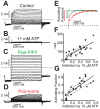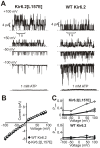Voltage-dependent gating in a "voltage sensor-less" ion channel
- PMID: 20208975
- PMCID: PMC2826373
- DOI: 10.1371/journal.pbio.1000315
Voltage-dependent gating in a "voltage sensor-less" ion channel
Abstract
The voltage sensitivity of voltage-gated cation channels is primarily attributed to conformational changes of a four transmembrane segment voltage-sensing domain, conserved across many levels of biological complexity. We have identified a remarkable point mutation that confers significant voltage dependence to Kir6.2, a ligand-gated channel that lacks any canonical voltage-sensing domain. Similar to voltage-dependent Kv channels, the Kir6.2[L157E] mutant exhibits time-dependent activation upon membrane depolarization, resulting in an outwardly rectifying current-voltage relationship. This voltage dependence is convergent with the intrinsic ligand-dependent gating mechanisms of Kir6.2, since increasing the membrane PIP2 content saturates Po and eliminates voltage dependence, whereas voltage activation is more dramatic when channel Po is reduced by application of ATP or poly-lysine. These experiments thus demonstrate an inherent voltage dependence of gating in a "ligand-gated" K+ channel, and thereby provide a new view of voltage-dependent gating mechanisms in ion channels. Most interestingly, the voltage- and ligand-dependent gating of Kir6.2[L157E] is highly sensitive to intracellular [K+], indicating an interaction between ion permeation and gating. While these two key features of channel function are classically dealt with separately, the results provide a framework for understanding their interaction, which is likely to be a general, if latent, feature of the superfamily of cation channels.
Conflict of interest statement
The authors have declared that no competing interests exist.
Figures








Similar articles
-
Current affairs: a mutation's-eye view of voltage gating.PLoS Biol. 2010 Feb 23;8(2):e1000314. doi: 10.1371/journal.pbio.1000314. PLoS Biol. 2010. PMID: 20186263 Free PMC article. No abstract available.
-
A threonine residue (Thr71) at the intracellular end of the M1 helix plays a critical role in the gating of Kir6.2 channels by intracellular ATP and protons.J Membr Biol. 2003 Mar 15;192(2):111-22. doi: 10.1007/s00232-002-1069-6. J Membr Biol. 2003. PMID: 12682799
-
A Kir6.2 pore mutation causes inactivation of ATP-sensitive potassium channels by disrupting PIP2-dependent gating.PLoS One. 2013 May 20;8(5):e63733. doi: 10.1371/journal.pone.0063733. Print 2013. PLoS One. 2013. PMID: 23700433 Free PMC article.
-
Voltage-gated proton (H(v)1) channels, a singular voltage sensing domain.FEBS Lett. 2015 Nov 14;589(22):3471-8. doi: 10.1016/j.febslet.2015.08.003. Epub 2015 Aug 18. FEBS Lett. 2015. PMID: 26296320 Review.
-
The voltage sensor in voltage-dependent ion channels.Physiol Rev. 2000 Apr;80(2):555-92. doi: 10.1152/physrev.2000.80.2.555. Physiol Rev. 2000. PMID: 10747201 Review.
Cited by
-
Decomposition of slide helix contributions to ATP-dependent inhibition of Kir6.2 channels.J Biol Chem. 2013 Aug 9;288(32):23038-49. doi: 10.1074/jbc.M113.485789. Epub 2013 Jun 24. J Biol Chem. 2013. PMID: 23798684 Free PMC article.
-
A Conserved Residue Cluster That Governs Kinetics of ATP-dependent Gating of Kir6.2 Potassium Channels.J Biol Chem. 2015 Jun 19;290(25):15450-15461. doi: 10.1074/jbc.M114.631960. Epub 2015 May 1. J Biol Chem. 2015. PMID: 25934393 Free PMC article.
-
Motifs in the permeation pathway of connexin channels mediate voltage and Ca (2+) sensing.Front Physiol. 2014 Mar 31;5:113. doi: 10.3389/fphys.2014.00113. eCollection 2014. Front Physiol. 2014. PMID: 24744733 Free PMC article. Review.
-
Non-trivial dynamics in a model of glial membrane voltage driven by open potassium pores.Biophys J. 2023 Apr 18;122(8):1470-1490. doi: 10.1016/j.bpj.2023.03.013. Epub 2023 Mar 13. Biophys J. 2023. PMID: 36919241 Free PMC article.
-
Electrophysiological Properties of Ion Channels in Ascaris suum Tissue Incorporated into Planar Lipid Bilayers.Korean J Parasitol. 2021 Aug;59(4):329-339. doi: 10.3347/kjp.2021.59.4.329. Epub 2021 Aug 18. Korean J Parasitol. 2021. PMID: 34470084 Free PMC article.
References
-
- Long S. B, Campbell E. B, MacKinnon R. Voltage sensor of Kv1.2: structural basis of electromechanical coupling. Science. 2005;309:903–908. - PubMed
-
- Ahern C. A, Horn R. Focused electric field across the voltage sensor of potassium channels. Neuron. 2005;48:25–29. - PubMed
-
- Bezanilla F. How membrane proteins sense voltage. Nat Rev Mol Cell Biol. 2008;9:323–332. - PubMed
-
- Grabe M, Lai H. C, Jain M, Jan Y. N, Jan L. Y. Structure prediction for the down state of a potassium channel voltage sensor. Nature. 2007;445:550–553. - PubMed
-
- Tombola F, Pathak M. M, Gorostiza P, Isacoff E. Y. The twisted ion-permeation pathway of a resting voltage-sensing domain. Nature. 2007;445:546–549. - PubMed
Publication types
MeSH terms
Substances
Grants and funding
LinkOut - more resources
Full Text Sources
Molecular Biology Databases

